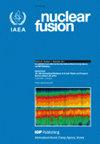具有 RMP-ELM 抑制边缘的等离子体性能和运行空间
IF 4
1区 物理与天体物理
Q1 PHYSICS, FLUIDS & PLASMAS
引用次数: 0
摘要
通过比较 AUG、DIII-D、EAST 和 KSTAR 静止运行点,研究了边缘定位模式(ELM)被共振磁扰动(RMP)抑制的等离子体的运行空间和全局性能。在一定范围内的等离子体电流、环形磁场和共振磁扰动环形模式数都能实现共振磁扰动-ELM抑制。在各装置中发现了一致的边缘安全系数运行窗口,而等离子体整形参数窗口则各不相同。访问基座参数后发现,所有设备的 RMP-ELM 抑制基座顶密度极限都非常相似,都略高于 m-3。考虑到许多工程参数和边缘碰撞性的巨大差异,这一结果令人惊讶,并对该机制的推断提出了挑战。我们观察到输入功率、束缚时间和存储能量的范围很广,所实现的三乘积与电流、磁场和半径的乘积相似。本文介绍了 RMP-ELM 抑制等离子体工程参数的能量禁锢缩放观察结果,并与已建立的 H 模式和 L 模式缩放预期结果进行了比较,包括对不确定性分析的处理。与既定标度相比,各工程参数的标度指数有所不同。然而,外推到下一步的热核聚变实验堆 ITER 和 SPARC 发现,在不确定性范围内,总体上与既定标度一致,从组装的多设备 RMP-ELM 抑制数据库外推时,没有发现明显的性能损失。总之,这项工作确定了 RMP-ELM 抑制的共同物理原理,并强调了在更高磁场和不同等离子体物理尺寸下追求这种无ELM 机制的必要性。本文章由计算机程序翻译,如有差异,请以英文原文为准。
Plasma performance and operational space with an RMP-ELM suppressed edge
The operational space and global performance of plasmas with edge-localized modes (ELMs) suppressed by resonant magnetic perturbations (RMPs) are surveyed by comparing AUG, DIII-D, EAST, and KSTAR stationary operating points. RMP-ELM suppression is achieved over a range of plasma currents, toroidal fields, and RMP toroidal mode numbers. Consistent operational windows in edge safety factor are found across devices, while windows in plasma shaping parameters are distinct. Accessed pedestal parameters reveal a quantitatively similar pedestal-top density limit for RMP-ELM suppression in all devices of just over m−3. This is surprising given the wide variance of many engineering parameters and edge collisionalities, and poses a challenge to extrapolation of the regime. Wide ranges in input power, confinement time, and stored energy are observed, with the achieved triple product found to scale like the product of current, field, and radius. Observed energy confinement scaling with engineering parameters for RMP-ELM suppressed plasmas are presented and compared with expectations from established H and L-mode scalings, including treatment of uncertainty analysis. Different scaling exponents for individual engineering parameters are found as compared to the established scalings. However, extrapolation to next-step tokamaks ITER and SPARC find overall consistency within uncertainties with the established scalings, finding no obvious performance penalty when extrapolating from the assembled multi-device RMP-ELM suppressed database. Overall this work identifies common physics for RMP-ELM suppression and highlights the need to pursue this no-ELM regime at higher magnetic field and different plasma physical size.
求助全文
通过发布文献求助,成功后即可免费获取论文全文。
去求助
来源期刊

Nuclear Fusion
物理-物理:核物理
CiteScore
6.30
自引率
39.40%
发文量
411
审稿时长
2.6 months
期刊介绍:
Nuclear Fusion publishes articles making significant advances to the field of controlled thermonuclear fusion. The journal scope includes:
-the production, heating and confinement of high temperature plasmas;
-the physical properties of such plasmas;
-the experimental or theoretical methods of exploring or explaining them;
-fusion reactor physics;
-reactor concepts; and
-fusion technologies.
The journal has a dedicated Associate Editor for inertial confinement fusion.
 求助内容:
求助内容: 应助结果提醒方式:
应助结果提醒方式:


